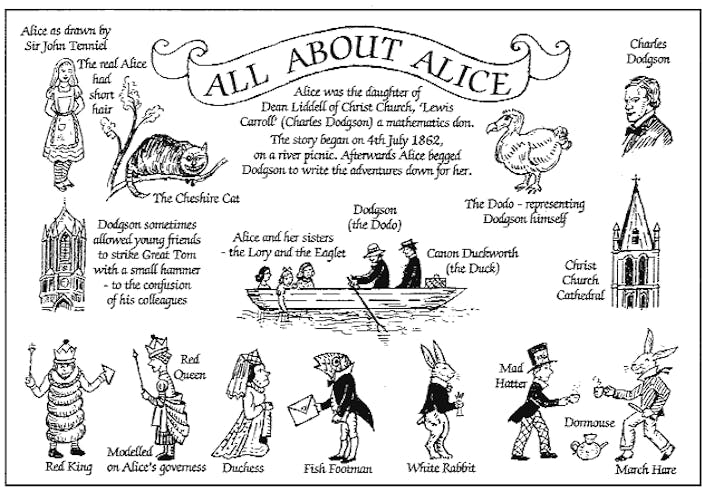All About Alice

For Christmas 1864, Charles Dodgson gave Alice Liddell a handwritten story, with his own drawings, called Alice's Adventures Underground. The version with which most of us are familiar - Alice's Adventures in Wonderland, illustrated by Sir John Tenniel - was published a year later. The Wonderland title was suggested by Dean Liddell, Alice's father, whom classical scholars will recognise as co-author of the Greek Lexicon Liddell and Scott.
Dodgson had hoped to use his own illustrations for the printed version, but Ruskin (who was also Alice's drawing master) told him that they showed insufficient talent to warrant spending the time to improve them. Ruskin appears in the book as 'an old conger eel that used to come once a week' to teach 'drawing, stretching and fainting in coils'.
It was agreed with Tenniel that his drawings should not resemble the real Alice, whose hair was short and dark. Photographs and a portrait by Dodgson show an intelligent, serious little girl with deep-set eyes and a heart-shaped chin, quite different from the popular image. Tenniel caricatured himself in the White Knight.
As for the original manuscript, Alice sold it to raise death duties when she was widowed in 1928. It went to an American dealer for £15,400. Now, however, it is in the British Museum, having been presented to us in 1948 by the Americans 'as the slightest token of recognition for the fact that (you) held off Hitler while we got ready for the war.' A facsimile edition is now available, published by Michael Joseph.
There is a story that Queen Victoria liked Alice's Adventures in Wonderland much that she wrote to ask Dodgson to send her a copy of his next book. Soon afterwards she received a Treatise on Determinants. Delightful though this story is, Dodgson denied it hotly, and wrote that it was "utterly false in every particular; nothing even resembling it has occurred".
Apparently Dodgson was inspired to write Alice through the Looking Glass after a conversation with a chemist about the chirality of molecules: some molecules such as glucose can be left-handed or right-handed, as shown by its ability to rotate plane-polarised light. Glucose can therefore be laevose, or dextrose, but only dextrose (the right-handed version) can be processed by the body. This led Dodgson to imagine a world where only laevose and right-handed amino acids were known, the opposite of our own. But of course he turned a good many other things upside down in it too.
It is easy to imagine how much Alice would have enjoyed Dodgson's bizarre distortions of events and characters in her own life, and as the daughter of a lexicographer, she must have shared the author's delight in word play. Much of the background to the book is explained in Alice's Adventures in Oxford by Mavis Batey (Pitkin Pictorials).



